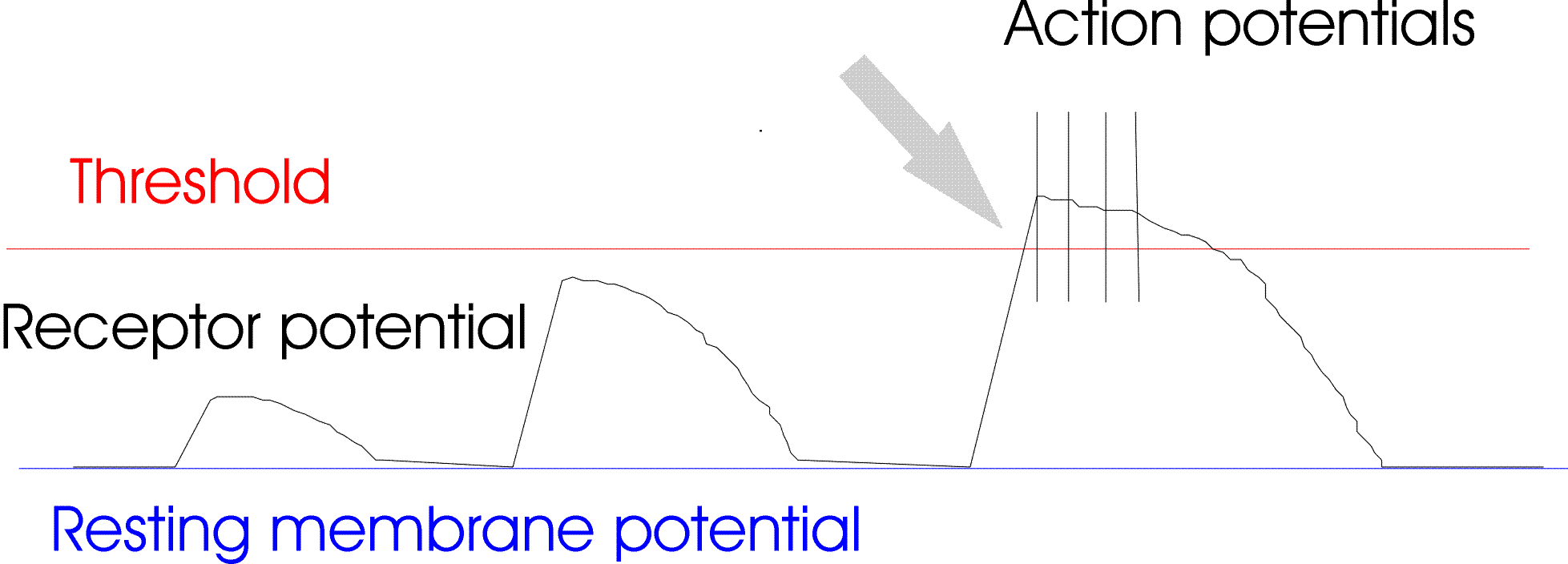Receptors and receptive fields
The Reverend Dr. David CM Taylor
dcmt@liverpool.ac.ukThis page is © David Taylor and The University of Liverpool, 1999
![]()
![]() Chapter 6 of Bray (Bray, Cragg, MacKnight, Mills & Taylor, Lecture Notes on Human Physiology 3rd Edition, 1994 Blackwell Scientific Publications),
Chapter 6 of Bray (Bray, Cragg, MacKnight, Mills & Taylor, Lecture Notes on Human Physiology 3rd Edition, 1994 Blackwell Scientific Publications),
![]() Chapter 4 of Carpenter (Carpenter, RHS, Neurophysiology 3rd Edition 1996, Arnold)
Chapter 4 of Carpenter (Carpenter, RHS, Neurophysiology 3rd Edition 1996, Arnold)
![]() Chapters 23 - 26 of Kandel (Kandel, Schwartz & Jessell, Principles of Neural Science 3rd Edition, 1991, Elsevier)
Chapters 23 - 26 of Kandel (Kandel, Schwartz & Jessell, Principles of Neural Science 3rd Edition, 1991, Elsevier)
As ever in neurophysiology, try not to get bogged down with the anatomy.
Five senses ?
This was a concept introduced by the ancient Greeks, and has little to recommend it. The main senses are shown below. Many neurophysiologists would include proprioception in the list - particularly the muscle receptors.
![]() hearing
hearing
![]() sight
sight
![]() touch
touch
![]() taste, smell
taste, smell
![]() temperature
temperature
![]() pain
pain
![]() balance, posture
balance, posture
Transduction
The simplest form of transduction is that shown by the molecular receptor, for instance those involved with
![]() taste
taste
![]() smell
smell
![]() chemoreception
chemoreception
![]() vision
vision
![]() nociception
nociception
![]() The binding of a molecule to a receptor causes a conformational change which results in a graded receptor potential
The binding of a molecule to a receptor causes a conformational change which results in a graded receptor potential
The alternatively, the deformation of the terminal region of the neurone can lead to a graded receptor potential as is the case in
![]() mechanoreception
mechanoreception
![]() balance
balance
![]() hearing
hearing
![]() joint receptors
joint receptors
![]() muscle spindles
muscle spindles
![]() nociception
nociception
A further alternative is when a change in temperature shifts the balance between an inhibitory process (e.g. the sodium/potassium pump) and an excitatory process (e.g. the inward "leakage" of calcium).
Transduction mechanisms are covered in Chapter 3 of Carpenter and chapter 23 of Kandel. But the level at which they have been covered in the lectures is as deep as you need to go. Provided, that is, that you understand the Generator potential in terms of ionic mechanisms (Nernst equation and so on). Once a threshold potential is reached, then the voltage activate sodium channels open in the usual way, and an action potential, or train of action potentials occur.

Receptive Fields
![]() may be large or small, depending upon the amount of branching of the peripheral nerve
may be large or small, depending upon the amount of branching of the peripheral nerve
![]() and the nature and depth of the receptor
and the nature and depth of the receptor
You should try to relate the location and the anatomy of the receptors to their characteristics described in most physiology textbooks.
Responses
![]() adaptation - rapid or slow
adaptation - rapid or slow
![]() Pacinian Corpuscles vs Merkel Cells
Pacinian Corpuscles vs Merkel Cells
![]() static and/or dynamic
static and/or dynamic
![]() joint and thermal receptors
joint and thermal receptors
![]() linear or bell shaped
linear or bell shaped
![]() again like joint or thermal receptors
again like joint or thermal receptors
These are treated well in most physiology textbooks. The one important detail that you should know, as mentioned in the lectures, is the observation that different sensory modalities are transmitted along fibres of different diameter and conduction velocity. This has consequences in the way that different sensations are perceived, it also means that if we know the conduction velocity of a given fibre we can predict the sensory modality it carries.
The Table below is derived from Bray (p.143) and Carpenter (p.32). Carpenter is especially good on this topic.
|
fibre type |
numerical equivalent |
Diameter m m |
Velocity m/s |
receptors |
modalities |
|
A b |
I and II |
4 - 16 |
30 - 70 |
Merkel cells, Ruffini endings, Meissner and Pacinian corpuscles, larger hairs |
Touch pressure, vibration, position sense |
|
A d |
III |
1 - 4 |
3 - 30 |
small hairs, free nerve endings |
touch, pressure, cold, pricking (1st) pain. Also 2nd pain in humans |
|
C |
IV |
0.5 - 2 unmyelinated |
< 2 |
thermoreceptors and nociceptors |
cold, warmth and dull pain 2nd |
![]()